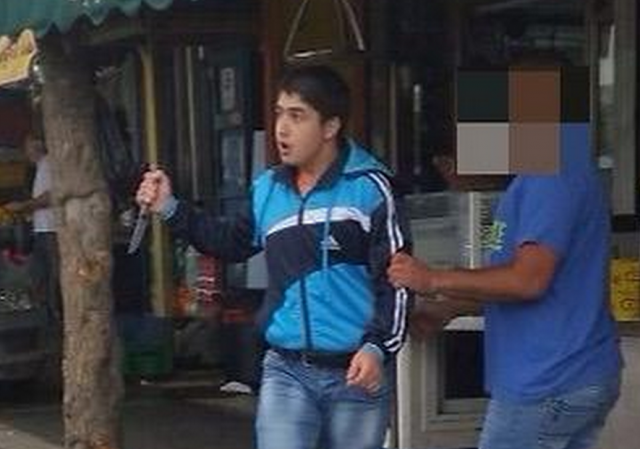Profiling works: How Israel stops the Palestinian “lone wolf” attacker
Many of these attackers fit a pattern.

The so-called Knife or Stabbing Intifada has not been limited to knives or stabbing. There have been shootings, bombings and car-rammings.
But one common denominator has been the “lone wolf” attacker — including women and early teens as young as 13.
Lone wolf attacks were actively encouraged throughout anti-Israel social media, and the attackers were treated as heroes.

When the attacker is not part of an organized group, it’s harder for intelligence services to prevent the attack from taking place. But after several dozen attacks and dozens of Israelis killed, the lone wolf attacks dwindled to a trickle. Certainly part of this was fatigue on the part of the Palestinian population, more aggressive policing and use of check points, and also monitoring of social media.
AFP reported in late July, Israeli experience shows challenge in stopping lone wolf attacks
Israeli authorities who have faced a wave of lone-wolf attacks by Palestinians say they have made progress in identifying potential assailants in advance, a challenge now also confronting Western nations.
Recent attacks in Europe and the United States have brought renewed attention to lone assailants and what can be done to stop them or reduce their impact.
While the challenge of halting such assaults can seem next to impossible, Israeli officials say an alert system incorporating social media monitoring, basic human intelligence and other means has helped prevent or limit bloodshed….
Israel’s military has developed an alert system that flags up those seen as potentially dangerous, the official said.
It is based on analyses of assailants since October, including their backgrounds, where they chose to act and their activities in the days before an attack.
With the list of names narrowed, Israeli authorities decide how to address the situation.
The response can include a range of strategies, such as monitoring, speaking to someone’s parents or an arrest if the person is found to have broken the law by inciting violence, the official said.
Security measures were also tightened in areas seen as potential targets.
In a post at its blog, the IDF explains the process used, including the importance of profiling the habits, behaviors and locations of lone wolf attackers, How can we prevent the next “lone wolf” attack?
It turns out there are patterns, and recognizing those patterns can help prevent an attack. It’s a type of profiling gained through experience:
1. Build an attacker profile
A lone wolf attacker can be anyone, but they’re more likely to fit a certain profile. In the past nine months, the IDF has been extensively researching lone wolf attacks and finding patterns that can help defend against them.
The Palestinian terrorists who carry out these attacks are most likely to be young, usually below 24 years of age, and sometimes even minors. About 90% of them are male and attackers usually come from the same six or seven villages. These attackers are motivated by the perceived success of terror attacks carried out by family members or others in their villages, and are inspired to attack in turn. Terrorists often strike the same five or six locations, turning places like the busy Gush Etzion Junction into a hotspot of stabbing and car ramming attacks.
Social media plays an important role not only in incitement, but also in signaling by would-be attackers. So monitoring social media is important:
2. Track the warning signs
Most people who fit the profile of an attacker will never become one. In order to find the people who present a high risk of radicalization, intelligence will flag individuals who are exhibiting warning signs. Those signs can be posts on social media that glorify terror, express suicidal thoughts, or express intent to attack. If a potential attacker hasn’t driven a car in six months, but suddenly rents an unregistered vehicle, it could indicate that he or she is about to carry out a car ramming attack.
Intelligence officers analyze high-risk cases, and if a potential attacker poses a threat, there are different approaches that security forces can take. Arresting the terrorist before they can carry out an attack can save dozens of lives. Sometimes, though, the situation calls for a discussion with a potential attacker’s family to bring their social media posts to their attention, or notifying the local security forces.
The other factors listed in the IDF blog were keeping weapons out of lone wolf attackers by cutting off the many illegal weapons factories, and fighting more organized terrorist groups like Hamas which often provide logistical support.
Profiling works when done correctly.
Donations tax deductible
to the full extent allowed by law.








Comments
Profiling works in places where, like Israel, there exists the political will to apply it. It cannot work (and will never, at least officially) be employed in places without that will, such as Europe and the U.S.
Thus, the debate isn’t about really about profiling, despite the zany leftist thought experiments that “demonstrate” the possibility that yes, the terrorist just might be a 70 year old blue eyed Swedish Lutheran. Profiling works; so does enhanced interrogation; and so would far stricter immigration limits from Muslim majority countries.
But the problem is politics not efficacy. The EU has a swelling Fifth Column; ours grows more slowly, but Muslim immigration has become an important virtue signaling device for U.S. elites.
Profiling works in places where, like Israel, there exists the political will to apply it. It cannot work (and will never, at least officially) be employed in places without that will, such as Europe and the U.S.
It works here, too — at least it does when you can get the BlackLivesMatter crowd to calm down long enough to see the “profiling” is behavior-based and not race-based (yeah, right! LOL!). That’s the pattern I noticed about Israel’s “profiling”: they’re looking at certain behaviors in real life and on social media. Where a person is born/raised factors in to some extent, but they’re mostly assessing current and recent behavior and location.
Our police could — and often do — do that, too. It’s called “reasonable articulable suspicion”, which considers a totality of circumstances and observations (up to and including location [i.e. a “high-crime area”] and being “known to police”, a la Freddie Gray and the latest Milwaukie fiasco), and contrary to BLM claims is a bit more in-depth than, “He’s a black male”.
“Profiling” is a very different tactic from the “racial profiling” that gave profiling a bad name.
A handful of villages, and the same families. These kids aren’t lone wolves. They are cannon fodder.
“Profiling” is something all of us do every day, constantly. It’s how people deal with reality.
Doing it intentionally, intelligently is a good thing. It does not imply “prejudice” in the racial context. It does not imply religious bigotry. It can and should simply mean we deal with reality, and use our resources most intelligently.
I’d like to offer you some candy to celebrate Muhammad’s being turned into an annuity from the Palestinian Authority for his family.